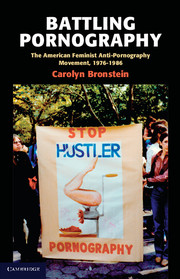Book contents
- Frontmatter
- Contents
- List of Figures
- Acknowledgments
- Introduction: Battling Pornography
- 1 Seeds of Discontent
- 2 Male Violence and the Critique of Heterosexuality
- 3 Have You Seen Deep Throat Yet?
- 4 “I'm Black and Blue from the Rolling Stones and I Love It!”
- 5 Something Inside Me Just Went “Click”
- 6 Growing Pains
- 7 Porn Tours
- 8 The New Lay of the Land
- 9 Anti-Pornography Comes Undone
- Conclusion: Porn Is Here to Stay
- Bibliography
- Index
- References
5 - Something Inside Me Just Went “Click”
Women Against Violence in Pornography and Media and the Transition to an Anti-Pornography Movement
Published online by Cambridge University Press: 05 June 2012
- Frontmatter
- Contents
- List of Figures
- Acknowledgments
- Introduction: Battling Pornography
- 1 Seeds of Discontent
- 2 Male Violence and the Critique of Heterosexuality
- 3 Have You Seen Deep Throat Yet?
- 4 “I'm Black and Blue from the Rolling Stones and I Love It!”
- 5 Something Inside Me Just Went “Click”
- 6 Growing Pains
- 7 Porn Tours
- 8 The New Lay of the Land
- 9 Anti-Pornography Comes Undone
- Conclusion: Porn Is Here to Stay
- Bibliography
- Index
- References
Summary
In August 1977, Max Factor & Co. launched a major advertising campaign to promote its new line of skin cleansers and moisturizers. The multimedia campaign for the new “Self-Defense” products, which included television and radio spots, as well as newspaper advertisements and billboards, was introduced that summer to thirty major U.S. markets. The cosmetics company budgeted $1 million for the initial promotion, or “first flight” of the Self-Defense ads. The “second flight” would include a substantial push during the Christmas holidays. Conceived by the Los Angeles advertising agency of Wells, Rich and Greene, the Max Factor campaign used themes of public safety and environmental pollution to alert women to the danger posed to the skin by smog, dirt, and grime. The agency designed a stark billboard advertisement with blue and white graphics and large block print that resembled an official police bulletin. Its message read like one too. “Warning! A Pretty Face Isn't Safe In This City. Fight Back With Self-Defense.”
To a female audience keenly aware of male violence, self-defense was sound advice. At first glance, the Max Factor advertisements concurred. It was important for women to be vigilant on the streets and in their homes, on guard against the threats posed by rapists, muggers, and sexual harassers. Women's groups offered self-defense classes where women could learn karate, judo, and other techniques that could be used to fend off attackers.
- Type
- Chapter
- Information
- Battling PornographyThe American Feminist Anti-Pornography Movement, 1976–1986, pp. 127 - 172Publisher: Cambridge University PressPrint publication year: 2011



